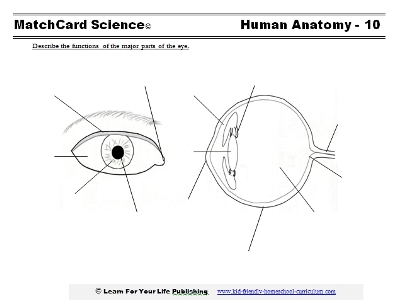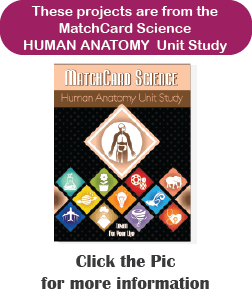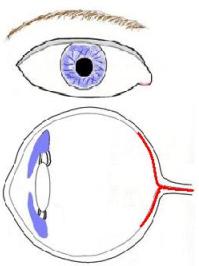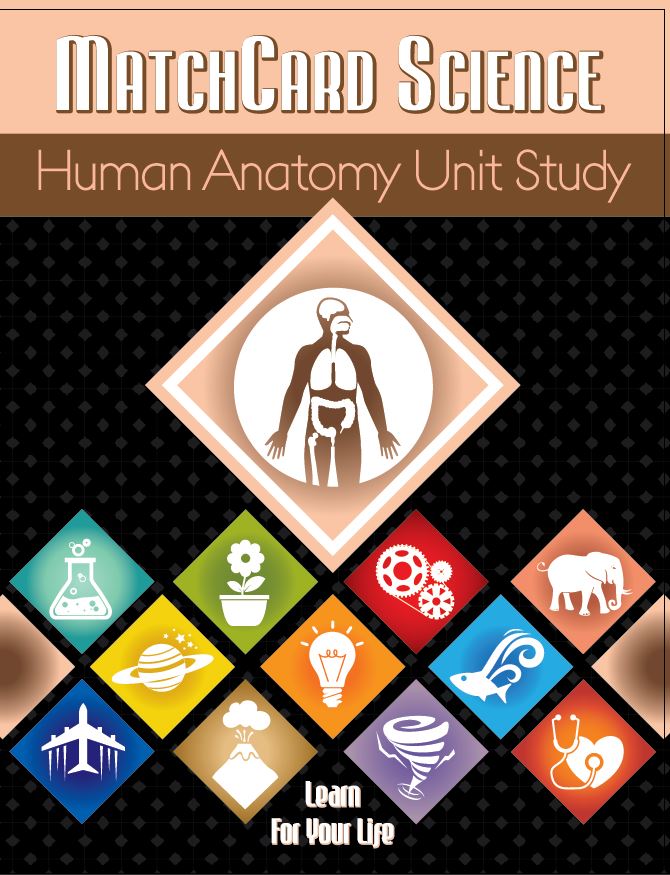Human Eye Diagram
Eye Worksheet For Kids in 3rd to 8th Grade
The human eye diagram on the MatchCard teaches the major parts of the eye and their function.
Free Download Below


MatchCard Science Human Eye Diagram and Worksheet
Objective: Describe the functions of the major parts of the eye.MatchCard: Download below.
MatchCard Information Pieces identify the location and function of the parts of the eye anatomy on the human eye diagram. Ideas for projects are listed on the instructor's page and below.
Here's the Human Eye Diagram to Download
This is MatchCard #10 of the Human Anatomy Unit Study. Learn more about MatchCards below.The 1st page is the students' worksheet. The student matches the name and descriptions with the diagram of the human eye.
The 2nd page is the Instructor's Guide with the correct answers.
The 3rd page has the Information Pieces. Student's cut them apart and place them in the correct place on their copy of the Matchcard.
Anatomy of the Human Eye
 Here are the names and functions of the major parts listed on the human eye worksheet:
Here are the names and functions of the major parts listed on the human eye worksheet:
- Eye Lid - Keeps the eye clean
- Iris - Colored part of the eye
- Pupil - Dark opening in the iris which allows light to enter the eye
- Sclera - White part of the eye
- Lacrimal Duct - Drains the tears that keep the eye moist and clean
- Conjunctiva - Clear, moist outer covering of the eye
- Cornea - Part of the clear conjunctiva that covers the iris and pupil
- Optic Nerve - Carries electrical signals to the brain
- Chamber - Small space between the cornea and iris
- Lens - Focuses the object by getting thicker of thinner
- Ciliary Muscle - Makes the iris larger or smaller and the lens thicker or thinner
- Vitreous Jelly - Clear substance that supports the shape of the eye
- Retina - The inside lining of the back of the eye that changes light waves into electrical signals
Activities, Projects, Experiments
Before showing the kids the human eye diagram on the Matchcard, do some of the hands on activities here.Pupils dilate and constrict
Use a penlight to show how the eyes constrict with light.If you do not have a penlight, you can make one out of a simple flashlight. Punch a small hole with a paper hole punch in black construction paper. Cut out the paper to cover the end of the flashlight. Only a small beam of light will go through the hole.
In a darkened room, shine the small beam of light onto a person's eye. Watch as the pupil constricts.
As you take the beam of light away, you can see the pupil dilate.
Eye lids
Make a list of what your eye lids are for.Have students time themselves to see how long they can go without blinking. What do their eyes feel like?
Peripheral Vision
Peripheral vision is what you see on the side of your head.Focus your eyes on something straight ahead of you.
Have a partner walk from one side of the room to the next, carrying a bright colored object.
State when you first see the object, and when you last see it. The entire time your eyes should be focused straight ahead.
Have someone else mark the areas where you first and last saw the object. That is the range of your peripheral vision.
Right Eyed - Left Eyed
Just as some people are right-handed or left-handed, they also have one eye that is more dominant than the other. (And it may not be the same side as their hand domination.)Let's check your eye domination. You will need a Cheerio or other object with a very small hole. You could even puncture a piece of paper with a pencil tip, but make the hole fairly smooth, please.
Hold your Cheerio or other hole at arm's length and look through it like a telescope. Look at a spot on the wall. While you are looking at it, close your right eye.
Do you still see the spot? You are right-eyed.
Oops, did the spot move? You are left-eyed.
Now close your left eye and see what happens.
Science Experiment - Does Color Affect Visibility
You can download pocket size Snelling charts to do this experiment.Test 10 people's visibility with the regular chart with black print on white paper.
Develop your own chart with the same size print and same words, but different color print. Try a variety of colors.
Which colors are more readable? Does changing the background color affect visibility? How much?
Can you write a hypothesis and develop a science experiment?
MatchCard Science
How To Use MatchCards

Download the FREE MatchCard Science Instructor's Guide and see how MatchCards can make building their science knowledge base fun.
Human Anatomy Unit Study

Download the entire Human Anatomy Unit Study
12 Science Unit Studies

Chemistry is only one of twelve complete unit studies for kids in 3rd to 8th grade.
Comprehensive objectives, hands-on projects, suggested science fair experiments, and the fun game-like MatchCards keep them interested in learning science. See all twelve MatchCard Science Unit Studies.
About Our Site
Hands-On Learning














